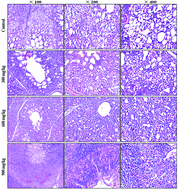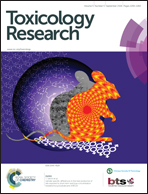Oxidative stress and inflammatory responses involved in dietary nickel chloride (NiCl2)-induced pulmonary toxicity in broiler chickens
Abstract
The respiratory system is the primary target of nickel or nickel compound toxicity after inhalation exposure. There are no reports on the effects of nickel or nickel compounds on the lung via dietary administration at present. This study aimed to investigate pulmonary toxicity induced by dietary NiCl2 in broiler chickens by using histopathology, qRT-PCR, and ELISA. In comparison with the control group, NiCl2 intake induced oxidative damage to DNA (upregulation of 8-OHdG) and lipid peroxidation (upregulation of MDA), which was associated with the upregulation of NO and the downregulation of the expression levels and activities of pulmonary CuZn-SOD, Mn-SOD, CAT, GSH-Px, GR and GST mRNA. Also, the T-AOC activity, GSH content, ability to inhibit the generation of hydroxyl radicals, and ratio of GSH/GSSG were decreased in the groups treated with NiCl2. Concurrently, the mRNA expression levels of iNOS, TNF-α, COX-2, IL-1β, IL-6, IL-8, IL-18 and IFN-γ were increased via the activation of NF-κB, and the mRNA expression levels of anti-inflammatory mediators including IL-2, IL-4 and IL-13 were decreased in the groups treated with NiCl2. The above-mentioned results were the first to demonstrate that NiCl2 intake induced pulmonary oxidative stress and inflammatory responses via the dietary pathway, which subsequently contributed to histopathological lesions and dysfunction.


 Please wait while we load your content...
Please wait while we load your content...